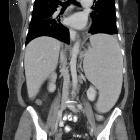Thrombotisch-thrombozytopenische Purpura
Thrombotic thrombocytopenic purpura (TTP) is a rare but life-threatening condition characterized by thrombocytopenia, microangiopathic hemolytic anemia and end-organ damage.
Epidemiology
The prevalence of TTP is ten cases per one million people . Ninety-percent of cases occur in adulthood and only ten percent occur in childhood . The condition is twice as common in women than men .
Clinical presentation
Originally a pentad of signs and symptoms was said to be present in TTP:
- neurological symptoms (e.g. weakness, headache, coma)
- renal insufficiency
- microangiopathic hemolytic anemia
- thrombocytopenia
- fever
However, it has been shown that all five are present in less than 10% of cases . In reality, a combination of any of the above should raise the possibility of TTP.
Purpura is usually present. Abdominal pain and chest pain from intestinal and cardiac ischemia are also common .
Pathology
Etiology
Normally a protease known as A Disintegrin and Metalloprotease with ThromboSpondin type 1 repeats, member 13 (ADAMTS13) is responsible for cleaving von Willebrand multimers and preventing the aggregation of von Willebrand factor and subsequent platelet activation and hyperadhesion. TTP is caused by an acquired or congenital deficiency in ADAMTS13 activity which produces inappropriate platelet clumping leading to thrombocytopenia. Destruction of red blood cells by these platelet clumps produces hemolytic anemia and embolization of these aggregates produces embolic events .
Ninety percent of cases are acquired with autoimmune inactivation of the protease by IgG autoantibodies. Antibodies are detectable in about 75% of acute cases . Approximately half of all TTP patients do not have a clear inciting condition or offending drug; this is known as idiopathic TTP. However, in the other half, underlying disease (e.g. SLE, HIV, cancer), pregnancy, organ transplantation or drugs (e.g. clopidogrel, cyclosporin A) may cause acquired autoantibodies . In roughly 2% of cases congenital deficiency of ADAMTS13 is the cause of TTP .
Markers
Activity of the ADAMTS13 enzyme may be measured and is specific for TTP and levels are reduced to under 10% of normal in TTP .
Radiographic features
CT
Approximately a quarter of patients have changes on brain CT with posterior reversible encephalopathy syndrome being present in half of these cases .
MRI
One study using MRI showed that 82% of patient with TTP had acute findings. Posterior reversible encephalopathy syndrome was present in half of these patients again. Acute cerebral ischemia and hemorrhage are uncommon findings. After treatment the majority of patients will reverse their imaging findings .
Treatment and prognosis
Plasma exchange is the first line treatment for TTP .
History and etymology
TTP was first described in 1924 by the American physician Eli Moschcowitz (1879-1964) in a 16-year-old girl .
Siehe auch:

 Assoziationen und Differentialdiagnosen zu Thrombotisch-thrombozytopenische Purpura:
Assoziationen und Differentialdiagnosen zu Thrombotisch-thrombozytopenische Purpura:
